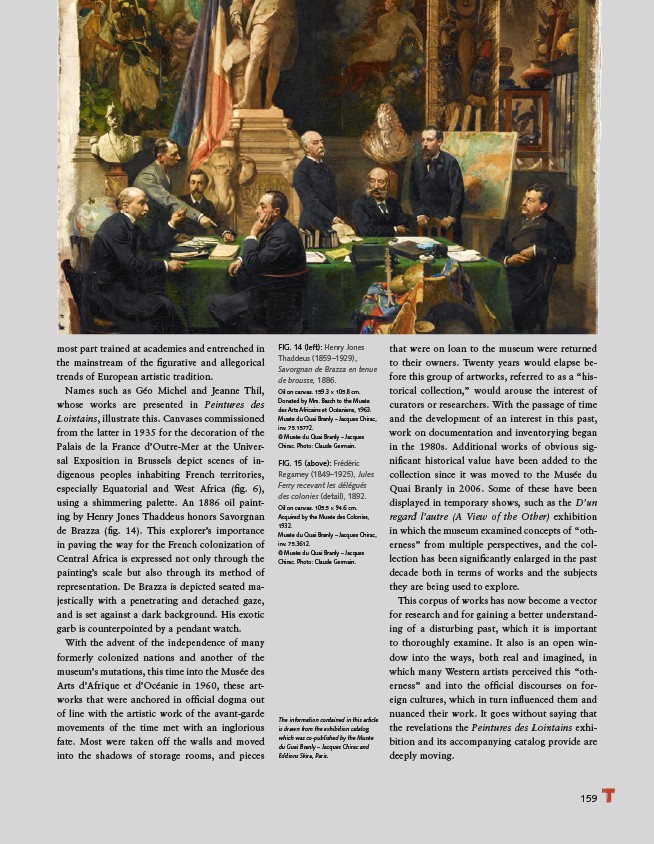
159
most part trained at academies and entrenched in
the mainstream of the fi gurative and allegorical
trends of European artistic tradition.
Names such as Géo Michel and Jeanne Thil,
whose works are presented in Peintures des
Lointains, illustrate this. Canvases commissioned
from the latter in 1935 for the decoration of the
Palais de la France d’Outre-Mer at the Universal
Exposition in Brussels depict scenes of indigenous
peoples inhabiting French territories,
especially Equatorial and West Africa (fi g. 6),
using a shimmering palette. An 1886 oil painting
by Henry Jones Thaddeus honors Savorgnan
de Brazza (fi g. 14). This explorer’s importance
in paving the way for the French colonization of
Central Africa is expressed not only through the
painting’s scale but also through its method of
representation. De Brazza is depicted seated majestically
with a penetrating and detached gaze,
and is set against a dark background. His exotic
garb is counterpointed by a pendant watch.
With the advent of the independence of many
formerly colonized nations and another of the
museum’s mutations, this time into the Musée des
Arts d’Afrique et d’Océanie in 1960, these artworks
that were anchored in offi cial dogma out
of line with the artistic work of the avant-garde
movements of the time met with an inglorious
fate. Most were taken off the walls and moved
into the shadows of storage rooms, and pieces
FIG. 14 (left): Henry Jones
Thaddeus (1859–1929),
Savorgnan de Brazza en tenue
de brousse, 1886.
Oil on canvas. 159.3 × 105.8 cm.
Donated by Mrs. Basch to the Musée
des Arts Africains et Océaniens, 1963.
Musée du Quai Branly – Jacques Chirac,
inv. 75.15772.
© Musée du Quai Branly – Jacques
Chirac. Photo: Claude Germain.
FIG. 15 (above): Frédéric
Regamey (1849–1925), Jules
Ferry recevant les délégués
des colonies (detail), 1892.
Oil on canvas. 105.5 × 94.6 cm.
Acquired by the Musée des Colonies,
1932.
Musée du Quai Branly – Jacques Chirac,
inv. 75.3612.
© Musée du Quai Branly – Jacques
Chirac. Photo: Claude Germain.
The information contained in this article
is drawn from the exhibition catalog,
which was co-published by the Musée
du Guai Branly – Jacques Chirac and
Editions Skira, Paris.
that were on loan to the museum were returned
to their owners. Twenty years would elapse before
this group of artworks, referred to as a “historical
collection,” would arouse the interest of
curators or researchers. With the passage of time
and the development of an interest in this past,
work on documentation and inventorying began
in the 1980s. Additional works of obvious signifi
cant historical value have been added to the
collection since it was moved to the Musée du
Quai Branly in 2006. Some of these have been
displayed in temporary shows, such as the D’un
regard l’autre (A View of the Other) exhibition
in which the museum examined concepts of “otherness”
from multiple perspectives, and the collection
has been signifi cantly enlarged in the past
decade both in terms of works and the subjects
they are being used to explore.
This corpus of works has now become a vector
for research and for gaining a better understanding
of a disturbing past, which it is important
to thoroughly examine. It also is an open window
into the ways, both real and imagined, in
which many Western artists perceived this “otherness”
and into the offi cial discourses on foreign
cultures, which in turn infl uenced them and
nuanced their work. It goes without saying that
the revelations the Peintures des Lointains exhibition
and its accompanying catalog provide are
deeply moving.